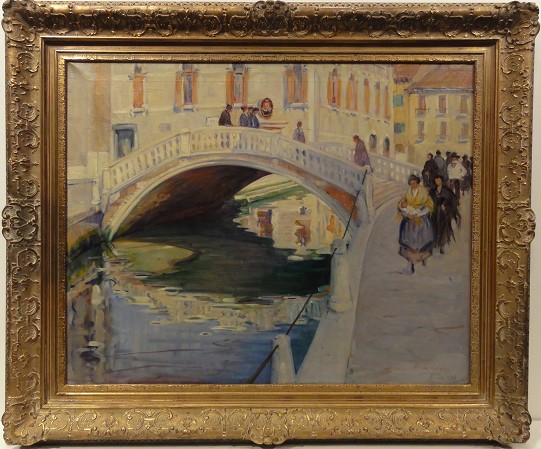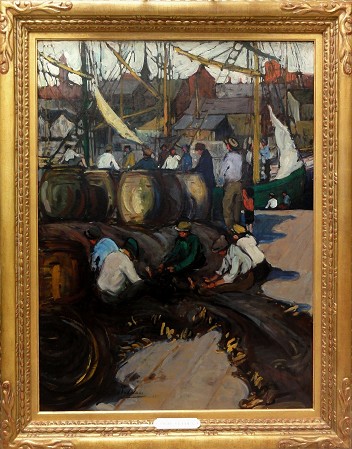by Kevin Ott
Although this is not a proper “show” of Selden’s work, there are 5 paintings displayed at the Eisele Gallery, more than one can usually find in one location by this respected Cincinnati artist and favorite student of Frank Duvenek.
First the gallery: Eisele Gallery specializes in 19th and 20th Century paintings (and some prints) and often has work by some of Cincinnati’s historically most esteemed painters. Eisele focuses on the past, with works by Julia De Forest, John Weis, Henry Mosler, and Potthast, but also the present, as they represent living artists such as John Ruthven, Beverly Erschell, Sally Schrohenloher, Robert Off and John Stobart. Paintings are tightly grouped across the gallery’s walls and in the center of the largest room on temporary walls and even on the floor leaning against the furniture. One could say it is a bit cluttered or, if your glass is half full that day, that they have plenty of inventory to peruse. In this vein, the five Selden paintings are scattered in three locations around the gallery.
Dixie Selden (1868-1935) was born in Cincinnati and lived mostly in Covington. She studied at the McMicken School of Design which became the Art Academy in 1885, where she continued to study under Frank Duveneck. But, maybe equally importantly, she travelled to Venice in 1910 and studied under William Merritt Chase and then under Henry Snell in England. Through this time period she travelled extensively throughout Europe as well as Asia, Scandinavia and Mexico. No doubt the top notch instruction and world travel informed and influenced Selden’s style. Under Chase she learned to paint quickly and impressionistically with dabs and slashes of paint. She lived in Brittany for a while developing her impressionist style, doing seascapes and landscapes.
The five paintings at Eisele are all impressionist. Two are Venice-scapes, presumably from when she lived there and studied under Chase . “View of Venice” has a foreground of shimmering water, just one gondolier afloat. The very Venetian buildings fill the upper half of the painting, their reflections lending color and interest to the watery foreground. A nice painting, with a dream-like quality. The other larger Venetian painting, “Venice 2” is a canal scene with the water and the arched bridge the focus. Pedestrians on the bridge and the adjacent sidewalk are rendered in quick dabs and strokes of paint, their faces mere smudges. There is no mistaking the location. Once again, it is a pleasing painting.
The largest Selden painting in the show, “Mending the Nets” at 40’x30”, is a busy, gritty waterfront scene. The background, or upper portion, is a jumble of buildings, roofs, masts and sails. Five figures sit on the decking in the foreground, surrounded by shipping barrels, mending a flowing net, bent over their work, caps on heads. It is a swirl of color, an active and engaging picture.
Two smaller paintings hang at the far end of the room, both seemingly Parisian…but neither is. “Riverside Drive” depicts two figures on a park bench, trees with various greens and a walkway of highlights and shadows. This impressionistic view feels French, but it is New York. Similarly, “Shadows and Light” portrays a lone figure on a road carrying what may be laundry, the face a blur of orange, the trees very Cezanne-esque and the light shimmering through the trees to melt the sidewalk in color fused reflections. Both of these are successful paintings.
As one of the top tier of deceased Cincinnati artists, Selden probably deserves a proper show of her work. This is not exactly it, but it is a chance to see five of her paintings in one place.






